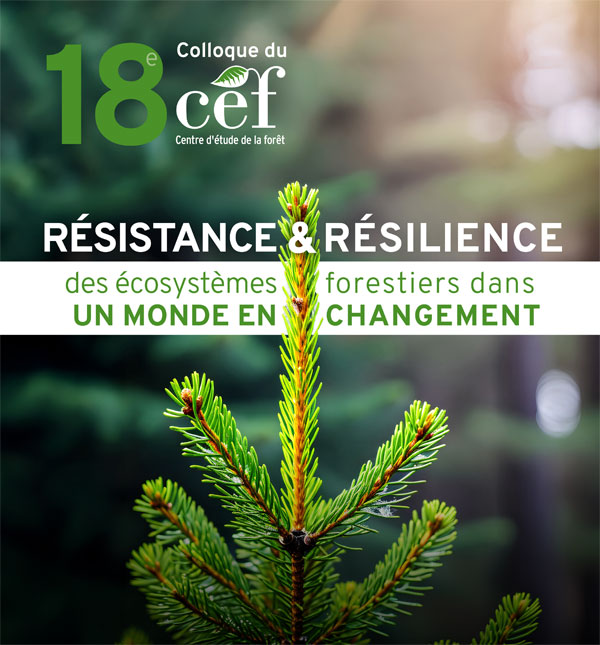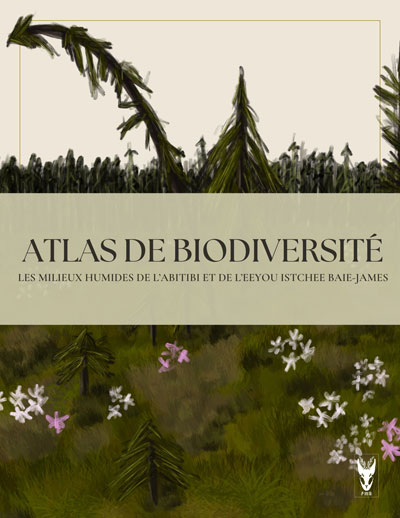
Marc J. Mazerolle
Professeur titulaire
Biologie de la conservation, estimation de paramètres démographiques, statistiques
Université Laval
Département des sciences du bois et de la forêt
Bureau 2119
2405 rue de la Terrasse
Québec, Québec G1V OA6, Canada
(418) 656-2131 Poste 407120
marc.mazerolle@sbf.ulaval.ca
AFFILIATIONS ACADÉMIQUES
- Professeur titulaire, Sciences du bois et de la forêt, Université Laval (2024 - présent)
- Professeur agrégé, Sciences du bois et de la forêt, Université Laval (2020 - 2024)
- Professeur adjoint, Sciences du bois et de la forêt, Université Laval (2015 - 2020)
- Professeur associé, Sciences biologiques, Université de Montréal (2009 - 2012)
- Professeur associé, Sciences appliquées, Université du Québec en Abitibi-Témiscamingue (2009 - )
- Professeur associé, Department of biology, Queen's University (2013 - 2016)
FONCTIONS
- Directeur du Centre d'étude de la forêt - U. Laval (2023 - présent)
- Directeur du programme de baccalauréat en environnements naturels et aménagés (2018 - présent)
FORMATION
- Postdoctorat en écologie des mouvements, 2006 (McGill University, Montréal, QC, Canada; Dr. David M. Green)
- Postdoctorat en biostatistiques, 2005 (USGS Patuxent Wildlife Research Center - Maryland, USA; Dr. James D. Nichols)
- Ph.D. en sciences forestière, 2004 (Université Laval; Dr. André Desrochers et Line Rochefort)
- M.Sc. (biology), 1999 (Dalhousie University; Dr. Richard J. Wassersug)
- B.Sc. (biologie), 1997 (Université de Moncton)
THÈMES DE RECHERCHE
Mon programme de recherche vise à quantifier et modéliser les mécanismes influençant les dynamiques de populations animales dans des environnements forestiers sous différents types de perturbations (espèces exotiques, coupe, routes, agriculture) et à différentes échelles spatiales. J’utilise surtout les amphibiens comme organismes modèles, bien que certains de mes travaux portent sur les reptiles, les oiseaux, les communautés de petits mammifères et certaines espèces végétales. Mes travaux s’effectuent sur le terrain, impliquent des études de capture-marquage-recapture, des expériences en mésocosmes et des exercices de modélisation sur des serveurs de Calcul Québec. Je m’intéresse particulièrement aux approches permettant d’estimer les paramètres démographiques après avoir tenu compte de la probabilité de détection imparfaite. Pour ce faire, j’utilise des approches fréquentistes et bayésiennes.
RÉALISATIONS RÉCENTES
Parmi mes réalisations récentes, j'ai développé et je continue à développer activement le package AICcmodavg ![]() en R afin de réaliser de la sélection de modèle et de l'inférence multimodèle sur différents types de modèles, ainsi que des diagnostics de modèles tenant compte de la détection imparfaite. Ce package, disponible sur le site de R, est cité dans plus de 2112 publications (Google Scholar, 1 juin 2021). Les travaux récents de mon laboratoire portent sur la distribution et le rétablissement des populations de rainettes faux-grillons boréales au Québec (M. Dubois-Gagnon, M.Sc.; A. Fayard, M. Sc.; J. Ethier, Ph. D.), ainsi que des salamandres de ruisseaux (A. Baillet, M. Sc.). Dans un autre projet, nous quantifions les dynamiques de colonisation d'étangs vernaux en milieux adjacents à la coupe forestière (R. Besançon, M. Sc.), ainsi que les communautés de vertébrés suite à la migration assistée d'arbres. Nous nous intéressons également à l'impact des routes sur les dynamiques de colonisations et extinctions ainsi que sur les paramètres démographiques de populations d'amphibiens en milieux humides à proximité des routes (L. Milliard, M. Sc.; M. Girard-Robert, M. Sc.; T.Calvé. M. Sc., F. Retamal-Diaz M. Sc.). Nous nous intéressons également au potentiel des enregistreurs automatisés acoustiques pour mieux comprendre la répartition et la phénologie de vertébrés qui vocalisent (M. Feldman, Ph. D.; J. Spooner, M. Sc.).
en R afin de réaliser de la sélection de modèle et de l'inférence multimodèle sur différents types de modèles, ainsi que des diagnostics de modèles tenant compte de la détection imparfaite. Ce package, disponible sur le site de R, est cité dans plus de 2112 publications (Google Scholar, 1 juin 2021). Les travaux récents de mon laboratoire portent sur la distribution et le rétablissement des populations de rainettes faux-grillons boréales au Québec (M. Dubois-Gagnon, M.Sc.; A. Fayard, M. Sc.; J. Ethier, Ph. D.), ainsi que des salamandres de ruisseaux (A. Baillet, M. Sc.). Dans un autre projet, nous quantifions les dynamiques de colonisation d'étangs vernaux en milieux adjacents à la coupe forestière (R. Besançon, M. Sc.), ainsi que les communautés de vertébrés suite à la migration assistée d'arbres. Nous nous intéressons également à l'impact des routes sur les dynamiques de colonisations et extinctions ainsi que sur les paramètres démographiques de populations d'amphibiens en milieux humides à proximité des routes (L. Milliard, M. Sc.; M. Girard-Robert, M. Sc.; T.Calvé. M. Sc., F. Retamal-Diaz M. Sc.). Nous nous intéressons également au potentiel des enregistreurs automatisés acoustiques pour mieux comprendre la répartition et la phénologie de vertébrés qui vocalisent (M. Feldman, Ph. D.; J. Spooner, M. Sc.).
Vous pouvez télécharger toutes mes références bibliographiques en format BibTeX, BibTeX-CSV, FRQNT ou EndNote
PUBLICATIONS
Livres
Aucun
Chapitres de livre
- Théberge, D., Beaudoin, J.-M., Asselin, H., St-Jean, É., Mazerolle, M.J., Bouthillier, L., Ben Mansour, J. (2022) Les employeurs forestiers sont-ils prêts à accueillir les travailleurs autochtones? Résultats d'une enquête au Québec dans le contexte de pénurie de main-d'oeuvre. In Les diversités en emploi : perspectives et enjeux au Québec et au Canada. (A. Lechaume, C. Fleury, C. Prévost, Eds., Eds.) Presses de l'Université Laval, pages 333-367
- Bailey, L. L., Mazerolle, M.J. (2010) Population estimation methods for amphibians and reptiles. In Ecotoxicology of amphibians and reptiles. (Krest, S., Bishop, C., Linder, G. and Sparling, D., Eds.) New York, NY, USA, Routledge/Taylor & Francis, pages 541-550
Livres, numéros spéciaux et actes de colloques publiés à titre d'éditeur
Aucun
Articles révisés par un comité de lecture
- Ola, A., Devos, W., Bouchard, M., Mazerolle, M.J., Raymond, P., Munson, A.D. (2024) Above- and belowground carbon stocks under differing silvicultural scenarios. Forest Ecology and Management, 558:121785
- Roy, D.B., Alison, J., August, T.A., Belisle, M., Bjerge, K., Bowden, J.J., Bunsen, M.J., Cunha, F., Geissmann, Q., Goldmann, K. et al. (2024) Towards a standardized framework for AI-assisted, image-based monitoring of nocturnal insects. Philosophical Transactions of the Royal Society B: Biological Sciences, 379(1904):20230108
- James, R., Bennett, J.R., Wilson, S., Adams, G., McIlwrick, K., Mazerolle, M.J., Smenderovac, E., Honeyman, K., Swystun, T., Hamel, B. et al. (2024) Modelling the occupancy of two bird species of conservation concern in a managed Acadian Forest landscape: Applications for forest management. Forest Ecology and Management, 555:121725
- Feldman, M.J., Mazerolle, M.J., Imbeau, L., Fenton, N.J. (2024) Using Camera Traps to estimate Habitat Preferences and Occupancy Patterns of Vertebrates in Boreal Wetlands. Wetlands, 44(14)
- Perez-Granados, C., Feldman, M.J., Mazerolle, M.J. (2024) Combining two user-friendly machine learning tools increases species detection from acoustic recordings. Canadian Journal of Zoology, 102(4):403-409
- Bell-Doyon, P., Mazerolle, M.J., Belanger, L., Fenton, N.J., Villarreal A., J.C. (2024) Differential impact of clearcut and insect outbreak on boreal lichens and bryophytes 50 years after disturbance. Biological Conservation, 295:110672
- Ethier, J.P., Worth, M., Mazerolle, M.J., Trudeau, V.L. (2024) Rearing density and food variety impact growth, development, and survival of larvae in the declining amphibian, Pseudacris maculata. Zoo Biology, 43(5):416-424
- Suffice, P., Mazerolle, M.J., Imbeau, L., Cheveau, M., Asselin, H., Drapeau, P. (2023) Site occupancy by American martens and fishers in temperate deciduous forests of Québec. Journal of Mammalogy, 104(1):159-170
- Feldman, M.J., Mazerolle, M.J., Imbeau, L., Fenton, N.J. (2023) Beaver activity and red squirrel presence predict bird assemblages in boreal Canada. Ornithology, 140(2):ukad009
- Kerric, A., Mazerolle, M.J., Giroux, J.-F., Verreault, J. (2023) Halogenated flame retardant exposure pathways in urban-adapted gulls: Are atmospheric routes underestimated? Science of the Total Environment, 860:160526
- Feldman, M.J., Mazerolle, M.J., Imbeau, L., Fenton, N.J. (2023) Occupancy and Abundance of Pond-Breeding Anurans in Boreal Landscapes. Journal of Herpetology, 57(2):159-171
- McCune, F., Normandin, E., Gervais, A., Mazerolle, M.J., Fournier, V. (2023) Syrphid fly response to urban heat islands varies with functional traits. Journal of Insect Conservation, 27:693–705
- Kerric, A., Mazerolle, M.J., Sorais, M., Giroux, J.-F., Verreault, J. (2023) Impact of landfill characteristics on the atmospheric exposure to halogenated flame retardants in gulls. Chemosphere, 343:140207
- Dubois-Gagnon, M.-P., Bernatchez, L., Belisle, M., Dubois, Y., Mazerolle, M.J. (2022) Distribution of the boreal chorus frog (Pseudacris maculata) in an urban environment using environmental DNA. Environmental DNA, 4(2):326 – 338
- Bloin, P., Mazerolle, M.J., Hébert, C. (2022) Effects of the seasonal availability of freshly cut logs and tree species on the early response of saproxylic insects in boreal forest. Forest Ecology and Management, 511:120114
- Casabona I Amat, C., Adde, A., Mazerolle, M.J., Lepage, C., Darveau, M. (2022) Breeding expansion of sandhill cranes in Quebec. The Journal of Wildlife Management, 86(3):e22169
- Feldman, M.J., Chevallier, R., Mazerolle, M.J., Imbeau, L., Fenton, N.J. (2022) Eating frogs in the north: attempted predation of Tringa melanoleuca on boreal Lithobates adult frogs (Anura: Ranidae). Herpetology Notes (15):399-402
- Bell-Doyon, P., Bellavance, V., Belanger, L., Mazerolle, M.J., Villarreal, J.C. (2022) Bacterial, fungal, and mycorrhizal communities in the soil differ between clearcuts and insect outbreaks in the boreal forest 50 years after disturbance. Forest Ecology and Management, 523:120493
- Roy Proulx, S., Jutras, S., Leduc, A., Mazerolle, M.J., Fenton, N.J., Bergeron, Y. (2021) Partial Harvest in Paludified Black Spruce Stand: Short-Term Effects on Water Table and Variation in Stem Diameter. Forests, 12(3):271
- Feldman, M.J., Imbeau, L., Marchand, P., Mazerolle, M.J., Darveau, M., Fenton, N.J. (2021) Trends and gaps in the use of citizen science derived data as input for species distribution models: A quantitative review. PLOS ONE, 16(3):1-21
- Desjardins, E., Imbeau, L., Darveau, M., Mazerolle, M.J., Fenton, N.J. (2021) Waterfowl use of mine tailing ponds in comparison with beaver ponds in boreal eastern Canada. Avian Conservation and Ecology, 16(24)
- Gervais, A., Belisle, M., Mazerolle, M.J., Fournier, V. (2021) Landscape enhancements in apple orchards: Higher bumble bee queen species richness, but no effect on apple quality. Insects, 12(5)
- Sorais, M., Spiegel, O., Mazerolle, M.J., Giroux, J.-F., Verreault, J. (2021) Gulls foraging in landfills: Does atmospheric exposure to halogenated flame retardants result in bioaccumulation? Environment International, 147:106369
- Drapeau Picard, A.-P., Mazerolle, M.J., Larrivee, M., Rochefort, L. (2021) Impact of pool design on spider and dytiscid recolonization patterns in a restored fen. Restoration Ecology, 29(5)
- Caza-Allard, I., Mazerolle, M.J., Harris, L.N., Malley, B.K., Tallman, R.F., Fisk, A.T., Moore, J.-S. (2021) Annual survival probabilities of anadromous arctic char remain high and stable despite interannual differences in sea ice melt date. Arctic Science, 7(2):575-584
- Mazerolle, M.J., Lapointe St-Pierre, M., Imbeau, L., Joanisse, G. (2021) Woodland salamander population structure and body condition under irregular shelterwood systems. Canadian Journal of Forest Research, 51(9):1281-1291
- Ethier, J.P., Fayard, A., Soroye, P., Choi, D., Mazerolle, M.J., Trudeau, V.L. (2021) Life history traits and reproductive ecology of North American chorus frogs of the genus Pseudacris (Hylidae). Frontiers in Zoology, 18(1)
- Adde, A., Casabona i Amat, C., Mazerolle, M.J., Darveau, M., Cumming, S.G., O'Hara, R.B. (2021) Integrated modeling of waterfowl distribution in western Canada using aerial survey and citizen science (eBird) data. Ecosphere, 12(10)
- Maleki, K., Lafleur, B., Harvey, B.D., Mazerolle, M.J., Fenton, N.J. (2020) Changes in Deadwood and Understory Vegetation 12 Years after Partial and Clearcut Harvesting in Mixedwood Stands of Western Quebec, Canada. Forest Science, 66(3):337-350
- Suffice, P., Cheveau, M., Imbeau, L., Mazerolle, M.J., Asselin, H., Drapeau, P. (2020) Habitat, Climate, and Fisher and Marten Distributions. The Journal of Wildlife Management, 84(2):277-292
- Sorais, M., Mazerolle, M.J., Giroux, J.-F., Verreault, J. (2020) Landfills represent significant atmospheric sources of exposure to halogenated flame retardants for urban-adapted gulls. Environment International, 135
- McCune, F., Normandin, É., Mazerolle, M.J., Fournier, V. (2020) Response of wild bee communities to beekeeping, urbanization, and flower availability. Urban Ecosystems, 23(1):39-54
- Lapointe, J., Mazerolle, M.J., Duranseau, M., Fournier, P. (2020) Une population de tortues serpentines (Chelydra serpentina) confrontée à des captures accidentelles lors d’opérations de contrôle de castors. Le Naturaliste canadien, 144(1):43-55
- Lafleur, B., Harvey, B.D., Mazerolle, M.J. (2019) Partial cutting in mixedwood stands: Effects of treatment configuration and intensity on stand structure, regeneration, and tree mortality. Journal of Sustainable Forestry, 38(3):275-291
- Touihri, M., Seguy, M., Imbeau, L., Mazerolle, M.J., Bird, D.M. (2019) Effects of agricultural lands on habitat selection and breeding success of American kestrels in a boreal context. Agriculture, Ecosystems and Environment, 272:146 - 154
- Desjardins, C.F., Mazerolle, M.J., Verreault, J. (2019) Is the urban-adapted ring-billed gull a biovector for flame retardants? Environmental Pollution, 244:109-117
- Craig, C., Mazerolle, M.J., Taylor, P.D., Tremblay, J.A., Villard, M.-A. (2019) Predictors of habitat use and nesting success for two sympatric species of boreal woodpeckers in an unburned, managed forest landscape. Forest Ecology and Management, 438:134-141
- Venier, L.A., Swystun, T., Mazerolle, M.J., Kreutzweiser, D.P., Wainio-Keizer, K.L., McIlwrick, K.A., Woods, M.E., Wang, X. (2019) Modelling vegetation understory cover using LiDAR metrics. PLOS ONE, 14(11)
- Fauteux, D., Gauthier, G., Mazerolle, M.J., Coallier, N., Bêty, J., Berteaux, D. (2018) Evaluation of invasive and non-invasive methods to monitor rodent abundance in the Arctic. Ecosphere, 9(2):e02124-n/a
- Strukelj, M., Brais, S., Mazerolle, M.J., Pare, D., Drapeau, P. (2018) Decomposition Patterns of Foliar Litter and Deadwood in Managed and Unmanaged Stands: A 13-Year Experiment in Boreal Mixedwoods. Ecosystems, 21(1):68-84
- Moore, J.-S., Chapman, J.M., Mazerolle, M.J., Harris, L.N., Taylor, E.B. (2018) Premature alarm on the impacts of climate change on Arctic Char in Lake Hazen. Nature Communications, 9:3985
- Chavel, E.E., Imbeau, L., Mazerolle, M.J., Drapeau, P. (2017) Boreal small mammals show evidence of density-dependent patterns with area-sensitivity. Forest Ecology and Management, 400:485 - 501
- Lapointe St-Pierre, M., Labbe, J., Darveau, M., Imbeau, L., Mazerolle, M.J. (2017) Factors Affecting Abundance of Beaver Dams in Forested Landscapes. Wetlands, 37(5):941-949
- Chavel, E.E., Mazerolle, M.J., Imbeau, L., Drapeau, P. (2017) Comparative evaluation of three sampling methods to estimate detection probability of American red squirrels (Tamiasciurus hudsonicus). Mammalian Biology, 83:1-9
- Venier, L.A., Mazerolle, M.J., Rodgers, A., McIlwrick, K.A., Holmes, S., Thompson, D. (2017) Comparison of semiautomated bird song recognition with manual detection of recorded bird song samples [Comparaison de la reconnaissance semi-automatisée de chants d'oiseaux avec des détections manuelles d'échantillons de chants d'oiseaux enregistrés]. Avian Conservation and Ecology, 12(2)
- Barbe, M., Chavel, E.E., Fenton, N.J., Imbeau, L., Mazerolle, M.J., Drapeau, P., Bergeron, Y. (2016) Dispersal of bryophytes and ferns is facilitated by small mammals in the boreal forest. Ecoscience, 23(3-4):67-76
- Smith, J., Harvey, B.D., Koubaa, A., Brais, S., Mazerolle, M.J. (2016) Sprucing up the mixedwoods: Growth response of white spruce (picea glauca) to partial cutting in the eastern Canadian boreal forest. Canadian Journal of Forest Research, 46(10):1205-1215
- Bordeleau, S., Asselin, H., Mazerolle, M.J., Imbeau, L. (2016) « Is it still safe to eat traditional food? » Addressing traditional food safety concerns in aboriginal communities. Science of the Total Environment, 565:529 - 538
- Sunyer, P., Munoz, A., Mazerolle, M.J., Bonal, R., Espelta, J.M. (2016) Wood mouse population dynamics: Interplay among seed abundance seasonality, shrub cover and wild boar interference. Mammalian Biology, 81(4):372-379
- Suffice, P., Joanisse, G., Imbeau, L., Mazerolle, M.J., Lessard, G. (2015) Short-term effects of irregular shelterwood cutting on yellow birch regeneration and habitat use by snowshoe hare. Forest Ecology and Management, 354:160-169
- Roy, C., Mazerolle, M.J., Imbeau, L. (2015) Transforming Abandoned Farm Fields to Conifer Plantations Reduces Ruffed Grouse Density. Journal of Fish and Wildlife Management, 6(2):405-417
- Gentes, M.-L., Mazerolle, M.J., Giroux, J.-F., Patenaude-Monette, M., Verreault, J. (2015) Tracking the sources of polybrominated diphenyl ethers in birds: Foraging in waste management facilities results in higher DecaBDE exposure in males. Environmental Research, 138:361-371
- Mvolo, C.S., Koubaa, A., Beaulieu, J., Cloutier, A., Mazerolle, M.J. (2015) Variation in wood quality in white spruce (Picea glauca (Moench) Voss). Part I. defining the juvenile-mature wood transition based on tracheid length. Forests, 6(1):183-202
- Bourque, N.R., Villard, M.-A., Mazerolle, M.J., Amirault-Langlais, D., Tremblay, E., Jolicoeur, S. (2015) Piping Plover response to coastal storms occurring during the nonbreeding season. Avian Conservation and Ecology, 10(1)
- Mazerolle, M.J. (2015) Estimating Detectability and Biological Parameters of Interest with the Use of the R Environment. Journal of Herpetology, 49(4):541-559
- Lapointe, J., Tremblay, J.A., Mazerolle, M.J., Imbeau, L., Maisonneuve, C. (2015) Habitat du faucon pèlerin dans le sud du Québec durant la période de reproduction : conséquences pour l’implantation de parcs éoliens. Le Naturaliste canadien, 139(1):30-37
- Lessard, E., Fournier, R.A., Luther, J.E., Mazerolle, M.J., van Lier, O.R. (2014) Modeling wood fiber attributes using forest inventory and environmental data for Newfoundland's boreal forest. Forest Ecology and Management, 313:307-318
- Uprety, Y., Asselin, H., Bergeron, Y., Mazerolle, M.J. (2014) White pine (Pinus strobus L.) regeneration dynamics at the species' northern limit of continuous distribution. New Forests, 45(1):131-147
- Drobyshev, I., Niklasson, M., Mazerolle, M.J., Bergeron, Y. (2014) Reconstruction of a 253-year long mast record of European beech reveals its association with large scale temperature variability and no long-term trend in mast frequencies. Agricultural and Forest Meteorology, 192-193:9-17
- Priol, P., Mazerolle, M.J., Imbeau, L., Drapeau, P., Trudeau, C., Ramiere, J. (2014) Using dynamic N-mixture models to test cavity limitation on northern flying squirrel demographic parameters using experimental nest box supplementation. Ecology and Evolution, 4(11):2165-2177
- Bose, A.K., Schelhaas, M.-J., Mazerolle, M.J., Bongers, F. (2014) Temperate forest development during secondary succession: Effects of soil, dominant species and management. European Journal of Forest Research, 133(3):511-523
- Lesbarreres, D., Ashpole, S.L., Bishop, C.A., Blouin-Demers, G., Brooks, R.J., Echaubard, P., Govindarajulu, P., Green, D.M., Hecnar, S.J., Herman, T. et al. (2014) Conservation of herpetofauna in northern landscapes: Threats and challenges from a Canadian perspective. Biological Conservation, 170:48-55
- Mazerolle, M.J., Perez, A., Brisson, J. (2014) Common reed (Phragmites australis) invasion and amphibian distribution in freshwater wetlands. Wetlands Ecology and Management, 22(3):325-340
- Fauteux, D., Mazerolle, M.J., Imbeau, L., Drapeau, P. (2013) Site occupancy and spatial co-occurrence of boreal small mammals are favoured by late-decay woody debris. Canadian Journal of Forest Research, 41:419-427
- Lapointe, J., Imbeau, L., Tremblay, J.A., Maisonneuve, C., Mazerolle, M.J. (2013) Habitat use by Female Peregrine Falcons (Falco peregrinus) in an agricultural landscape. Auk, 130(2):381-391
- Perez, A., Mazerolle, M.J., Brisson, J. (2013) Effects of exotic common reed (Phragmites australis) on wood frog (Lithobates sylvaticus) tadpole development and food availability. Journal of Freshwater Ecology, 28(2):165-177
- Jobin, B., Mazerolle, M.J., Bartok, N.D., Bazin, R. (2013) Least Bittern occupancy dynamics and detectability in Manitoba, Ontario, and Quebec. Wilson Journal of Ornithology, 125(1):62-69
- Fauteux, D., Imbeau, L., Drapeau, P., Mazerolle, M.J. (2012) Small mammal responses to coarse woody debris distribution at different spatial scales in managed and unmanaged boreal forests. Forest Ecology and Management, 266:194-205
- Bois, G., Imbeau, L., Mazerolle, M.J. (2012) Recovery time of snowshoe hare habitat after commercial thinning in boreal Quebec. Canadian Journal of Forest Research, 42(1):123-133
- Trudeau, C., Imbeau, L., Drapeau, P., Mazerolle, M.J. (2012) Winter site occupancy patterns of the northern flying squirrel in boreal mixedwood forests. Mammalian Biology, 77(4):258-263
- Lavoie, C., Belzile, F., Brisson, J., De Blois, S., Dumont, P., Gauthier, G., Hatin, D., Mazerolle, M.J., Morin, J. (2012) Le roseau envahisseur: la dynamique, l'impact et le contrôle d'une invasion d'envergure. Le Naturaliste canadien, 136:33-39
- Desrochers, A., Tardif, J., Mazerolle, M.J. (2012) Use of large clear-cuts by Wilson's Warbler in an eastern Canadian boreal forest. Avian Conservation and Ecology, 7(2):--
- Gravel, M., Mazerolle, M.J., Villard, M.-A. (2012) Interactive effects of roads and weather on juvenile amphibian movements. Amphibia-Reptilia, 33(1):113-127
- Breininger, D.R., Mazerolle, M.J., Bolt, M.R., Legare, M.L., Drese, J.H., Hines, J.E. (2012) Habitat fragmentation effects on annual survival of the federally protected eastern indigo snake. Animal Conservation, 15(4):361-368
- Villard, M.-A., Mazerolle, M.J., Hache, S. (2012) L'impact des routes, au-delà des collisions: le cas des oiseaux forestiers et des amphibiens. Le Naturaliste canadien, 136:61-65
- Trudeau, C., Imbeau, L., Drapeau, P., Mazerolle, M.J. (2011) Site occupancy and cavity use by the northern flying squirrel in the boreal forest. Journal of Wildlife Management, 75(7):1646-1656
- Roy, C., Imbeau, L., Mazerolle, M.J. (2010) Transformation of abandoned farm fields into coniferous plantations: Is there enough vegetation structure left to maintain winter habitat of snowshoe hares? Canadian Journal of Zoology, 88(6):579-588
- Park, Y.-I., Koubaa, A., Brais, S., Mazerolle, M.J. (2009) Effects of cambial age and stem height on wood density and growth of jack pine grown in boreal stands. Wood and Fiber Science, 41(4):346-358
- Hartmann, H., Beaudet, M., Mazerolle, M.J., Messier, C. (2009) Sugar maple (Acer saccharum Marsh.) growth is influenced by close conspecifics and skid trail proximity following selection harvest. Forest Ecology and Management, 258(5):823 - 831
- Hario, M., Mazerolle, M.J., Saurola, P. (2009) Survival of female common eiders Somateria m. mollissima in a declining population of the northern Baltic Sea. Oecologia, 159(4):747-756
- Mazerolle, M.J., Poulin, M. (2007) Persistence and colonisation as measures of success in bog restoration for aquatic invertebrates: A question of detection. Freshwater Biology, 52(2):383-385
- Mazerolle, M.J., Bailey, L.L., Kendall, W.L. abd Royle, J.A., Converse, S.J., Nichols, J.D. (2007) Making great leaps forward: Accounting for detectability in herpetological field studies. Journal of Herpetology, 41(4):672-689
- Mazerolle, M.J., Poulin, M., Lavoie, C., Rochefort, L., Desrochers, A., Drolet, B. (2006) Animal and vegetation patterns in natural and man-made bog pools: implications for restoration. Freshwater Biology, 51:333-350
- Mazerolle, M.J., Vos, C.C. (2006) Choosing the safest route: Frog orientation in an agricultural landscape. Journal of Herpetology, 40(4):435-441
- Mazerolle, M.J. (2006) Improving data analysis in herpetology: Using Akaike's information criterion (AIC) to assess the strength of biological hypotheses. Amphibia-Reptilia, 27(2):169-180
- Mazerolle, M.J., Desrochers, A., Rochefort, L. (2005) Landscape characteristics influence pond occupancy by frogs after accounting for detectability. Ecological Applications, 15(3):824-834
- Mazerolle, M.J., Desrochers, A. (2005) Landscape resistance to frog movements. Canadian Journal of Zoology, 83(3):455-464
- Mazerolle, M.J., Huot, M., Gravel, M. (2005) Behavior of amphibians on the road in response to car traffic. Herpetologica, 61(4):380-388
- Mazerolle, M.J. (2005) Peatlands and green frogs: A relationship regulated by acidity? Ecoscience, 12(1):60-67
- Mazerolle, M.J. (2005) Drainage ditches facilitate frog movements in a hostile landscape. Landscape Ecology, 20(5):579-590
- Mazerolle, M.J. (2004) Amphibian road mortality in response to nightly variations in traffic intensity. Herpetologica, 60(1):45-53
- Mazerolle, M.J., Cormier, M. (2003) Effects of peat mining intensity on green frog (Rana clamitans) occurrence in bog ponds. Wetlands, 23(4):709-716
- Mazerolle, M.J. (2003) Detrimental effects of peat mining on amphibian abundance and species richness in bogs. Biological Conservation, 113(2):215-223
- Mazerolle, M.J. (2003) Using rims to hinder amphibian escape from pitfall traps. Herpetological Review, 34(3):213-215
- Mazerolle, M.J., Drolet, B., Desrochers, A. (2001) Small-mammal responses to peat mining of southeastern Canadian bogs. Canadian Journal of Zoology, 79(2):296-302
- Mazerolle, M.J. (2001) Amphibian activity, movement patterns, and body size in fragmented peat bogs. Journal of Herpetology, 35(1):13-20
- Mazerolle, M.J., Villard, M.-A. (1999) Patch characteristics and landscape context as predictors of species presence and abundance: A review. Ecoscience, 6(1):117-124
Articles publiés dans des actes de colloque (proceedings)
Aucun
Rapports scientifiques, manuels et autres
- Besançon, R., Mazerolle, M.J. (2018) Impact de l’âge du peuplement sur la qualité des étangs vernaux et l’ef- fort reproducteur des amphibiens. Technical report, Rapport d’étape soumis à la Direction générale Gaspésie-Îles-de-la-Madeleine du Ministère des Forêts, de la Faune et des Parcs.
- Mazerolle, M.J. (2017) Impact de l’âge du peuplement sur la qualité des étangs vernaux et les dynamiques de communautés d’amphibiens. Rapport d’étape soumis à la Direction générale Gaspésie-Îles-de-la-Madeleine du Ministère des Forêts, de la Faune et des Parcs. Technical report, Rapport d’étape soumis à la Direction générale Gaspésie-Îles-de-la-Madeleine du Ministère des Forêts, de la Faune et des Parcs.
- Mazerolle, M.J. (2016) Impact de l’âge du peuplement sur la qualité des étangs vernaux et les dynamiques de communautés d’amphibiens. Technical report, Rapport préliminaire soumis à la Direction générale Gaspésie-Îles-de-la-Madeleine du Ministère des Forêts, de la Faune et des Parcs
- Mazerolle, M.J. (2003) Night driving surveys as an amphibian monitoring technique in Kouchibouguac National Park, 1995-2002. Parks Canada - Ecosystem Monitoring and Data Reports 9, Parks Canada
- Belisle, M., Imbeau, L., Mazerolle, M.J. (2001) Dénombrements de rapaces diurnes par l’Observatoire d’oiseaux de Tadoussac: recommandations pour l’analyse statistique des tendances de populations. Technical report, Observatoire d’oiseaux de Tadoussac. Programme de recherche de Explos-Nature, Beauport, Québec, Canada
- Mazerolle, M.J. (1999) Amphibian distribution and activity in Kelly's Bog, Kouchibouguac National Park. Technical Reports in Ecosystem Science 25, Parks Canada
- Mazerolle, M.J. (1998) Distribution et interactions intraspécifiques et interspécifiques chez les salamandres Eurycea bislineata bislineata (Green) et Plethodon cinereus (Green) en habitat riverain à l'intérieur du Parc national Kouchibouguac, Nouveau-Brunswick. Rapports Techniques en Matière de Sciences des Écosystèmes 14, Parks Canada
Thèses, mémoires et essais
- Mazerolle, M.J. (2004) Mouvements et reproduction des amphibiens en tourbières perturbées. Thèse de doctorat, Universite Laval (Canada)
- Mazerolle, M.J. (1999) Amphibians in fragmented peat bogs: abundance, activity, movements and size. Mémoire de maîtrise, Dalhousie University
Thèses, mémoires et essais supervisés
- Baillet, A. (2024) Impact de l’aménagement forestier sur les populations de salamandres pourpres. Mémoire de maîtrise, Université Laval
- Feldman, M. (2023) Les effets relatifs des variables caractérisant les petits étangs, et des interactions avec les prédateurs, sur l’occupation et l’abondance des espèces de trois groupes de vertébrés dans le Nord-du-Québec. Thèse de doctorat, Université du Québec en Abitibi-Témiscamingue
- Milliard, L. (2022) Utilisation des bassins de rétention d'eaux pluviales dans les emprises routières par les amphibiens. Mémoire de maîtrise, Université Laval
- Casabona I Amat, C. (2020) Dynamique d’occupation du territoire québécois par la grue du Canada. Mémoire de maîtrise, Université Laval
- Besançon, R. (2020) Effet de l’hydropériode et du volume de débris ligneux grossiers tombés au sol sur l’effort reproducteur d’amphibiens forestiers se reproduisant en étangs vernaux. Mémoire de maîtrise, Université Laval
- Retamal Diaz, F. (2020) Impact des infrastructures sous la route sur les populations d’amphibiens. Mémoire de maîtrise, Université Laval
- Saadouni, R. (2019) Modélisation de la vulnérabilité et de la détérioration des routes forestières : cas du Témiscamingue. Mémoire de maîtrise, Université du Québec en Abitibi-Témiscamingue
- Lamoureux, S. (2019) Suivi de la sélection des habitats forestiers par les chasseurs et les gélinottes dans la réserve faunique de Portneuf. Essai de maîtrise. Mémoire de maîtrise, Université Laval
- Chavel, E.E. (2018) Étude des facteurs affectant la détection et rôle de la quantité d'habitat sur les petits mammifères à faible capacité de dispersion en paysage perturbé du Québec. Thèse de doctorat, Université du Québec en Abitibi-Témiscamingue
- Lapointe St-Pierre, M. (2018) L’impact des coupes progressives irrégulières sur les populations de salamandre cendrée (Plethodon cinereus) dans les peuplements mixtes. Mémoire de maîtrise, Université Laval
- Labadie, M. (2017) Effet à retardement de l’ouverture de la canopée et de l’hydropériode sur le développement, la sélection d’habitat et la survie de la grenouille des bois. Mémoire de maîtrise, Université Laval
- Calve, T. (2017) Dynamique des populations d’amphibiens du Québec entre 1993 et 2013. Mémoire de maîtrise, Université du Québec en Abitibi-Témiscamingue
- Girard-Robert, M. (2016) Impact des routes sur la dynamique de colonisation et d'extinction d'amphibiens en milieux humides. Mémoire de maîtrise, Université du Québec en Abitibi-Témiscamingue
- Séguy, M. (2014) Utilisation de site de nidification et succès de reproduction chez la Crécerelle d’Amérique (Falco sparverius) en paysage agro-forestier boréal au Québec, Canada. Mémoire de maîtrise, Université du Québec en Abitibi-Témiscamingue
- Gagnon, J. (2013) Alimentation, sélection d'habitat et succès reproducteur de la petite nyctale (Aegolius acadicus) en forêt boréale mixte au Québec. Mémoire de maîtrise, Université du Québec en Abitibi-Témiscamingue
Articles non révisés par un comité de lecture
Aucun
<< Audrey Maheu | MembresReguliers | Christian Messier >>










